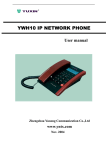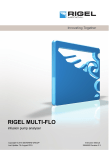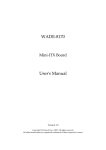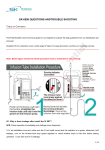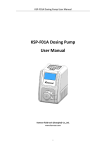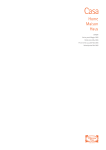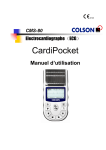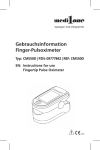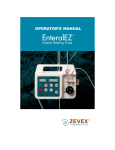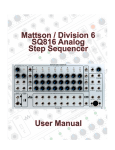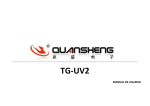Download V Series Infusion Pump User Manual
Transcript
V Series Infusion Pump User Manual Version 0.2 Sino Medical-Device Technology Co., Ltd Declarations: The information contained in this manual is based on the experiences and knowledge acquired by Sino Medical-Device Technology Co., Ltd. (Hereinafter referred to as Sinomdt) from the product field. Sinomdt is convinced that the information provided in this manual is accurate and reliable. But, we could not make any guarantees for the contents of this manual. As this manual is only used to provide the guidance for the use, operation and maintenance of infusion pump, Sinomdt shall not assume liability for the property damages or personal injuries caused by the citations of the contents of this manual for other purposes. This manual copyright is owned by Sinomdt, and no reproduction or dissemination of its content and information is allowed without the prior written permission of Sinomdt. The contents of this manual are subject to change without notice due to product upgrades or design improvements. Before the installation and application of V series infusion pump, please read this manual carefully. Contents 1. SAFETY INFORMATION.............................................................................................................. 1 1.1 Stipulations in the Manual ........................................................................................................ 1 1.2 Safety Overview........................................................................................................................ 1 1.3 Electrical / Mechanical Safety .................................................................................................. 2 1.3.1 Electrical Safety ............................................................................................................. 2 1.3.2 Application Safety.......................................................................................................... 2 1.4 Symbols and Labels .................................................................................................................. 4 1.4.1 Safety Symbols............................................................................................................... 4 1.4.2 Transport Symbols ......................................................................................................... 5 1.4.3 Product Labels................................................................................................................ 6 2. PRODUCT INTRODUCTION........................................................................................................ 6 2.1 Overview................................................................................................................................... 6 2.2 Designations Represented by Models ....................................................................................... 7 2.3 Operating Principle and Range of Application ......................................................................... 7 2.3 .1 Operating Principle ....................................................................................................... 7 2.3.2 Expected Purpose........................................................................................................... 8 2.3.3 Expected Suitable Object ............................................................................................... 8 2.3.4 Expected User ................................................................................................................ 8 2.3.5 Taboo.............................................................................................................................. 8 2.4 Technical Characteristics and Parameters ................................................................................. 8 2.4.3 Purge Rate ...................................................................................................................... 9 2.4.4 Delivery Search .............................................................................................................. 9 2.4.5 Delivery Limit................................................................................................................ 9 2.4.6 Occlusion Alarm Level .................................................................................................. 9 2.4.7 Bubble Detector ............................................................................................................. 9 2.4.8 KVO Rate....................................................................................................................... 9 2.4.9 History Record ............................................................................................................... 9 2.4.10 Alarm............................................................................................................................ 9 2.4.11 Power............................................................................................................................ 9 2.4.12 Environment............................................................................................................... 10 2.4.13 Dimension .................................................................................................................. 10 2.4.14 Net Weight.................................................................................................................. 10 2.4.15 Supported Brand......................................................................................................... 10 2.5 External Appearance & Structure............................................................................................ 10 2.6 Standard RS232 Interface ....................................................................................................... 13 2.7 Multi-Channel Injection .......................................................................................................... 14 3 . OPERATING METHODS............................................................................................................ 14 3.1 Pump Installation ................................................................................................................. 14 3.2 Power On ................................................................................................................................ 15 3.3 Power On/Off and System Self-test ........................................................................................ 16 3.4 Installation of Infusion Components ....................................................................................... 16 3.5 Selection of Infusion Mode..................................................................................................... 17 3.5.1 Speed Mode.................................................................................................................. 18 3.5.2 Drip Mode.................................................................................................................... 19 3.5.3 Body Weight Mode ...................................................................................................... 20 3.5.4 Time Mode ................................................................................................................... 21 3.5.5 Infusion Plan ................................................................................................................ 22 3.6 Infusion Parameters Setup....................................................................................................... 23 3.6.1 Infusion Rate Setup:..................................................................................................... 23 3.6.2 Preset Volume Setup..................................................................................................... 24 3.6.3 Delivery volume clear .................................................................................................. 25 3.6.4 Pressure Alarm Limit Quick Setting ............................................................................ 25 3.6.5 IV Set Parameter Selection .......................................................................................... 26 3.7 Advanced Parameter Setup ..................................................................................................... 27 3.7.1 Keypad Tone Setup ................................................................................................... 28 3.7.2 Alarm Tone Volume Setup............................................................................................ 28 3.7.3 Pressure Alarm Limit Setup ......................................................................................... 28 3.7.4 Bed Number Setup: ................................................................................................... 28 3.7.5 Bolus Rate Setup:...................................................................................................... 28 3.7.6 KVO Rate Setup :......................................................................................................... 29 3.7.7 Operating Light Switch Setup:.................................................................................. 29 3.7.8 Inquiry to Infusion History........................................................................................... 29 3.7.9 IV Set Calibration......................................................................................................... 30 3.7.10 Time Setup: ............................................................................................................. 31 3.7.11 Drip Sensor Switch Setup........................................................................................... 32 3.8 Bolus Function ........................................................................................................................ 32 3.9 Lighting Function.................................................................................................................... 32 3.10 Communication with Main Unit ........................................................................................... 33 3.11 Management of the Battery Recharging................................................................................ 33 3.11.1 Battery ........................................................................................................................ 33 3.11.2 Recharging ................................................................................................................. 33 4. ALARM PRESENTATION........................................................................................................... 34 4.1 Alarm of Non Operation.......................................................................................................... 34 4.2 Alarm of Not Calibration ........................................................................................................ 34 4.3 Alarm of Occlusion ................................................................................................................. 34 4.4 Alarm of Bubble...................................................................................................................... 34 4.5 Alarm of Door Open ............................................................................................................... 34 4.6 Alarm of Finish Infusion ......................................................................................................... 34 4.7 Alarm of KVO Completion..................................................................................................... 35 4.8 Alarm of Drip Sensor Abnormality ......................................................................................... 35 4.9 Alarm of Power Supply Breakdown ....................................................................................... 35 4.10 Alarm of Under Voltage Battery............................................................................................ 35 4.11 Alarm of Battery Running-out............................................................................................... 35 4.12 Alarm of System Error .......................................................................................................... 35 5. ANALYSIS OF MALFUNCTION AND TROUBLESHOOTING............................................. 37 6. MAINTENANCE............................................................................................................................ 38 7. NATURES OF INFUSION ............................................................................................................ 38 7.1 Natures of Rate Accuracy........................................................................................................ 38 7.2 Response to Occlusion ............................................................................................................ 40 8. STANDARD CONFIGURATION................................................................................................. 41 9. RELEVANT INFORMATION...................................................................................................... 41 1. Safety Information 1.1 Stipulations in the Manual The following information is applied in this manual to emphasize the hints on the messages relating to patients or devices or the potential risks. Caution: Be used to remind the situation in which the device or environmental damage may be caused. Warning: Be used to remind the situation in which injury or death may be caused. Attention: Be used to highlight the important guiding information which may have impact on how to use this manual and the product, or used to provide some additional information, such as detailed explanations, hints or reminders. 1.2 Safety Overview In accordance with the electrical safety classification, V Series Infusion Pump falls into Category I, CF type application part, continuous operation equipment, portable and IPX4 devices with internal power supply. The following is an overview of safety precautions: Operating personnel shall not be allowed to open the outer housing of device under any circumstances. It is not allowed to let the security function components of built-in device in a failure or short circuit condition. If the device fails to operate normally, it is not allowed to carry out repairs on your own. Instead, you should immediately contact with Sinomdt’s qualified personnel authorized to repair the equipment. No repair parts meeting your needs are available inside the equipment. Comply with all the warnings and attention hints, whether it is clearly defined or self-evident. Follow the stipulations specified in all safety labels on the equipment. 1 1.3 Electrical / Mechanical Safety Only those well-trained and qualified maintenance personnel authorized by the Sinomdt can open the outer housing of device and replace the electrical and mechanical components. Otherwise, problems of device safety may be caused. The following is an overview of warning message: 1.3.1 Electrical Safety Warning: Risk of electric shock - In order to protect patients and medical personnel, it is necessary to make sure that proper grounding of equipment is arranged, and protective grounding of power outlets remains intact. It is prohibited to have the triaxial cable of this device connected to twin wire socket. Warning: Risk of electric shock - It is prohibited to open the outer casing of device during the operating process or power connection. Only authorized maintenance engineers are allowed to open it. Caution: Before use, the user must check and make sure that there are no obvious damages, which may have impact on the patient safety or equipment performance. The recommended cycle of detection is once a week or a shorter period of time. It is recommended to replace the damaged parts before use if obvious damages are found out. Caution: Periodic safety tests of the instrument should be conducted to ensure the safety of device. The tests include leakage current measurement and insulation tests. The recommended test period is once a year, or the tests can be conducted in accordance with regulatory requirements and inspection procedures. Caution: Prior to the cleaning, the power cord should be removed. Use soft brush or soft cloth to wipe off the dust on the surface of device, use brush to remove the dust on the connector or the edge of panel, or use soft cloth soaked with neutral detergent / cold disinfectant or 70% alcohol and isopropyl alcohol to wipe off the dust. It is not allowed to let the detergent or disinfectant permeate into the internal part of device. Special attention should be paid to the connectors, edge of panel, and other locations. 1.3.2 Application Safety 2 Warning: It is prohibited to operate this device beyond the limits for operating environment. Otherwise, the device may be caused to operate abnormally. The operating environment is defined as follows: Operating temperature: +5 ~ +40 ℃ Relative Humidity: Relative humidity 20% ~ 90% Atmospheric Pressure: 86kPa ~ 106kPa Supply Voltage: 100-240 V~,50Hz/60Hz;12V Rate of Power: No more than 28VA Warning: Not suitable for the operation under the environment in which oxygen and nitrogen oxide flammable anesthetic are mixed. Otherwise, explosion may be caused. Warning: The application of inappropriate or misaligned IV set may cause inaccurate speed or dosage, and subsequently do harm to patients. Warning: We recommend to use the special IV set for pumps for injection, and We can not guarantee the accurates for other IV sets Warning: In order to ensure the injection processing, suggest to use the drip clamp Warning: this pump use the principle of extrusion to creep, do not use for blood transfusion Warning: Keep attention to avoid the air into the patient when use this product Warning: This product is not suitable for hyperbaric oxygen chamber and MRI inspection room. Warning: When using this device, attention should be paid to avoid the air admission which may do harm to the patients. Warning: In order to prevent the producing of the overspeed in the infusion, the users are suggested to connect the drip sensor with the host well before using of this product. Caution: Keep the environment clean and avoid shocks. Keep away from the aggressive chemicals, dusts, high temperature and humidity environment. 3 Caution: Electromagnetic interference - Make ensure that the installation and service environment of this instrument are not subject to strong electromagnetic interference, such as wireless transmitters or mobile phone interference. Attention: The protective cover should be arranged in place, provided that RS232 interface of device is not in use. Attention: Taboo drug(Insulin is not suitable for infusion pump injection, since insulin should be kept at a low temperature. Insulin should be injected quickly after leaving the low temperature environment). Attention: The IV set should fit with the National relative sanitation and quality standard for disposable goods; do not crossed use; after using the disposable IV set, the operator should deal with it as the medical rabbish Attention: Please use the power line, battery from Sinomdt, otherwise will possibly lead to irregular injection 1.4 Symbols and Labels 1.4.1 Safety Symbols "On / Off" or power connection Functional grounding Protective grounding Hazardous voltage Access to random file CF Type Application Part 4 AC Battery electric quantity Manufacturer Representative authorized by European Union Production date Serial number CE certification mark. The marked numeric code stands for the 0123 code of certification authority. Company Logo IPX4 Anti water level 4,splash proof,no bad infection when splashed by water from any direction Nonrecoverable mark 1.4.2 Transport Symbols Fragile: Handle with care Keep dry Humidity Storage Condition: It is not allowed to have the product exposed in the environment where the displayed humidity limit is exceeded. 5 During transportation, the atmospheric pressure shall be not more than 106KPa or less than 50KPa Temperature Condition: It is not allowed to have the product exposed in the environment where the displayed temperature limit is exceeded. Location: This side up 1.4.3 Product Labels Figure 1.4.3.1 SN-1800VR Label Figure 1.4.3.2 SN-1800V Label Figure 1.4.3.3 SN-1600VR Label Figure 1.4.3.4 SN-1600V Label 2. Product Introduction 2.1 Overview Microprocessor-based accuracy control motor as well as the pump tablet of drive finger-press type peristaltic pump shall be applied in V series infusion pump to enable the medicine to be injected into the patient body with uniform speed, accurate and safe dosage. During the clinical treatment, Vseries 6 infusion pump is applicable to internal medicine, surgery, pediatrics, obstetrics and gynecology, ICU, CCU ward and other clinical infusion therapies (Note: This product is strictly prohibited to be used in blood transfusion). Main features are listed as follows: ●A high degree of intelligence, dual-CPU chip, and real-time monitoring of the entire infusion process ensure a more secure and reliable infusion process. ● Wide range of infusion flow rate, namely, 1ml/h~1500ml/h ● Wide range of application, and suitable for 20 drops / ml and 60 drops / ml IV set. ● High-bright LED lamp is applied to indicate the state of alarm so that the cal personnel can clearly observe the state of infusion from a distance of 5 meters. ● Lighting lamp inside the pump. At night, it can be automatically switched on to facilitate the operation at night of medical personnel, as long as the pump gate is opened. ● History record. The history records of more than 1500 previous infusions can be kept. 2.2 Designations Represented by Models This series of products include the following Models: SN-1800V (Professional, without wireless communication function) SN-1800VR (Professional, with wireless communication function)) SN-1600V (Basic type, only support the speed mode and drip mode, no wireless communication function) SN-1600VR (Basic type, only support the speed mode and drip mode, no wireless communication function) In addition to the wireless communication function, the specification of this 4 models is almost the same. 2.3 Operating Principle and Range of Application 2.3 .1 Operating Principle The pump, falling into the category of volumetric type pump, is composed of finger-press type peristaltic pump, control system, and operation display system. The finger-press type peristaltic pump comprises motor, tape handler, peristaltic cam, wiggle cam, extrusion pump tablet, and press plate. At the time of operation, the micro processing chip controls the rotation of motor, and drive the peristaltic 7 shaft to rotate after the deceleration of tape handler. The peristaltic shaft drives the peristaltic cam to rotate, enabling extrusion pump tablets to conduct regular up and down movement under the extrusion of cam. The extrusion pump tablets alternatively extrude the infusion tube mounted between the press plate and extrusion tablet, and subsequently push the liquid medicine to move forward. The control system, consisting of dual-CPU chip, motor control module and so on, is applied to accurately control the flow rate of infusion and monitor the infusion status so that the safe and reliable infusion process can be guaranteed in the entire process. The operation display system, consisting of LCM, control panel, etc, is applied to realize the man-machine interaction and facilitate the operation of medical staffs. 2.3.2 Expected Purpose V series infusion pump is adapted to the hospital department of internal medicine, surgery, pediatrics, obstetrics and Gynecology, ICU, CCU room and other clinical infusion therapy (Note: This product is strictly prohibited for blood transfusion).This product should operated by qualified workers in hospital. 2.3.3 Expected Suitable Object Used for the drugs injection for adult, pediatric, neonatal, etc., used in Infusion therapy. . 2.3.4 Expected User The doctor, nurse or trained qualified medical staff in the hospital. 2.3.5 Taboo 1, Taboo drugs: insulin is not suitable for infusion pump injection. 2, This product is strictly prohibited for blood transfusion. 2.4 Technical Characteristics and Parameters 2.4.1 Rate Range of Adjustment 1ml/h - 1500ml/h, When the speed is at 1-99.9 ml/h, the flow rate of infusion increases by 0.1 mL; When the speed is above 100 mL/h, the flow rate of infusion increases by 1 mL/h. Measuring equipment calibration unit: ml/h 2.4.2 Accuracy Flow rate accuracy: less than ± 5% ( after calibration, accuracy can reach within 3%) 8 2.4.3 Purge Rate 200ml/h~1000ml/h,Adjustable 2.4.4 Delivery Search 0.1ml ~ 9999ml, Below 100ml, the accuracy is 0.1ml. Above 100ml, the accuracy is 1ml 2.4.5 Delivery Limit 0.1ml~9999ml, Adjust step 0.1ml. Above 100ml,the step is 1ml 2.4.6 Occlusion Alarm Level Infusion pump obstruction pressure's setting range is 100mmHg~900mmHg(13.3kPa~120kPa), Adjustable ten level, error is ± 50mmHg or ± 25% (6.6kpa), the bigger should be taken. 2.4.7 Bubble Detector Ultrasonic detection method, bubble above 25ul can detected. 2.4.8 KVO Rate 1~5ml/h, Adjustable, the default value is 2ml/h 2.4.9 History Record This series products can store more than 1500 historical records. Automatic record key operations and event information after system booting , including infusion start time, accumulation, flow rate, state,etc.. 2.4.10 Alarm In order to ensure the safety of infusion, this series products with the following warning or reminding function: over time, not calibration, occlusion, bubble, door open, finish, KVO completion, drip sensor abnormality, power supply breakdown, under voltage battery, battery running-out, system error. Detailed information see "Alarm Presentation" 2.4.11 Power Power supply voltage: A.C. 100V - 240V D.C. 12V Power frequency: 50/60Hz Battery voltage: DC 12V Battery working time: under full charge condition, Equipment can work more than 8 hours with a speed of 25ml/h Maximum power: 28VA Mode of operation: continuous operation with intermittent loading 9 Note: Before first use, battery charging time should reach to 12 hours. 2.4.12 Environment Working environment: Temperature: 5 ~ 40 C Humidity: 20% ~ 90% Transportation and storage condition: Temperature: -20~+55℃ Humidity: ≤ 95% 2.4.13 Dimension 129mm×130mm×215mm 2.4.14 Net Weight 1.8kg 2.4.15 Supported Brand The infusion pump can record 12 different manufacturers' IV sets, 20 drops of /ml, 60 drops of /ml included. the 12 manufacturers were: U_1、U_2、U_3、U_4、U_5、U_6、U_7、U_8、U_9、U_10、 U_11、U_12, "U_XX" number of IV set should pass the calibration function, then the corresponding IV set can be use. Warning: If the IV set without calibration, it may lead to inaccurate infusion. User choose IV set should get CE certificate, or get the allow for accessing into local medical equipment market. 2.5 External Appearance & Structure The main unit of infusion pump mainly consists of the outer casing, pump gate, operating panel, peristaltic pump, and drip sensor. Its external appearance and structure is shown in below Figure: 10 The specific descriptions of all parts are listed as follows: 1.System error Alarm Indicator -- used for alarm indication when system error occurred 2.AC Indicator -- the indicator lights up when connected to AC power, 3.Power key -- long press to turn on/off 4./5 Drip mode indicator /Speed mode indicator -- drop mode is different with other modes in digital display unit, it display lamp for displaying the current infusion data unit 6. LED Display—to show the speed data. 7.LCD Display -- to show the related data, status, alarm information,etc.. 8.Numeric Keypad -- for inputting numerical information, Number 3 and number 6 owns choosing upper or lower function. When you entered 3 or 6, except in the situation for choosing upper or lower, other situation only entered number 3 or number 6. 9.MENU Buttom/Return Button –Select the menu program and return //前一个 10.Confirm Button/Select Button---Select the program and enter it; Shift the parameters on the some interface to select the parameters. 11.Purge Button--Press the key and press it again for 5 seconds, Start the purge function. Release the 11 key to enable to stop it. 12.Silence Button/Clean Button--To be used for buzzer on-silencea after alarm; Enter the parameters, Reset the infusion amount. 13.Start Button/Pause Button--To be used for start or pause the infusion. 14.Tubing clamp —Clamp the pipeline after the pump gate is opened to avoid the excessive output of liquid medicine. 15.Jacklight— To be used for nighttime illumination. 16.Occlusion Sensor—Detect the pressure in infusion tube line. 17.Pump Fingers—Extrude the pipeline, enabling the liquid to be drained from the infusion components. 18.Pump Door—Fix the infusion tube line components to be mounted. 19.Door Handle—To be used for the opening and closing of pump gate, 20.Pressure Plate—Use constant pressure to hold down the pipeline of infusion components. 21.Bubble Sensor—Detect the air bubble in infusion tube line. 22.Drip Sensor---Detect the drip. 23.Infusion State Indicator/Alarm Indicator--The difference status, For examples,the infusion status, alarm status and so on, the indicator light can show different status and the indicator color 12 The name of all parts for infusion pump behind: 1. USB(interface)is used for the connection of other device.(Reserved Interface) 。 2. Drip sensor is used to detect the status of liquid drip inside the Murphy's dropper of IV set, and count the liquid drips splashed into the Murphy's dropper. 3. The fixation clamp is used for fixing infusion pump onto the infusion stand or bedstead. 4. Fixation handle--Rotating and adjusting the fixation which it is lock or release 5. Power supply interface is used for the connection of AC power supply. 6. DC 15V power output interface is used for output DV15V power supply. 7. RS232 interface is used for external communications. 8. DC12V Power input interface is used for the connection of 12v external DC power supply. 9. Calling nurse interface is used for the connection of nurse-calling system. 2.6 Standard RS232 Interface The pump has a standard RS232 interface and it is communicated each other. RS232 connected line is asked to use shielded wire an it should be accord with the standard request of information technique and safe standard for GB4943-2001. For more detailed information, Please ask our company to the RS232 interface agreement. The device must be connected with the specified equipment. 13 2.7 Multi-Channel Injection It is recommended that the infusion device use a one-way valve under using multi-channel injection. If there is no one-way value in the infusion tube, and it happened to be able to detect the block for the patient and it can lead to the drug corner. After release the block, the drug corner will inject the patient with unknown speed. It is very dangerous to the patient. 3 . Operating Methods The operating process of pump is listed as follows: 3.1 Pump Installation ● By rotating the fixation clamp at the back of device, it is possible to enable the device to be fixed onto the infusion stand . ●When pump is fixed onto the vertical strut, at first fixation clamp fixed onto the strut , clamp the 14 strut , and then rotating the fixation clamp and clamp the strut, it will fixed onto the vertical strut. 3.2 Power On After the external power supply is switched on, the external power indicator is on, the pump is at the power-on state. If the pump can't open and the current battery power is not enough , the pump will automatical charge. 15 3.3 Power On/Off and System Self-test After the external power supply is switched on, the external power indicator pump is at the power-on state. At this moment, press the is on, the key for 1 second to enable the start-up of device. Under the premise that the internal battery is used, the battery indicates the current battery power after the power switch is pressed to enable the start-up of device. The system starts to conduct self-test after the start-up of device. At this moment, the buzzing sound will be given out, the indicator and alarm light will bright up according to priority, and the pump will automatically check each of the functions (Note: All keys will be tested during the self-test process. In order to avoid an alarm for key error, please do not press any key). If there is no error message on the main interface of LCD screen after the self-test, that means the pump works normally. At the moment, the device is in standby state,. The pump will give out alarm if the system is in abnormal condition. For this regard, please refer to the description of alarm. After the external power supply is switched on, Press the key for seconds to enable switch off device. Under infusion status, Press to stop infusion, Press the key for seconds to enable switched off device. After power off, the data stored in the memory chip is not lost due to power off. 3.4 Installation of Infusion Components Make the infusion components ready. Hang the IV bottle (or bag) onto the IV stand (Note: the infusion bottle or bag should be placed 20cm ~ 80cm higher than the patient’s heart), open the package of IV set components, and close the roller clamp of IV set. After the infusion components are properly connected, use your hands to extrude the Murphy's dropper of IV set, and enable it to be filled with liquid (An appropriate filling amount is one third of the Murphy's dropper). Open the roller clamp, fill the infusion tube with infusion liquid to exhaust the air bubble, and then close the roller clamp. Properly install the infusion tube. Lift up the pump handle, open the door, start the installation from up to down, smoothly insert the tube into the pipe clamp, bubble sensor, and tubing clamp according to priority . After the pipeline installation is finalized, it is possible to lift up the door handle, ensure that the pulling hook of door handle has fastened the door locking pin, successively press down the latch handle and close the pump door. At this moment, the surface of door handle should be in parallel with the pump. If you select the “drip mode” or enable the “drip sensor alarm function” , the drip sensor 16 should be installed. Have the drip sensor installed between the top of Murphy's dropper nozzle and liquid level and try to keep the Murphy's dropper in the vertical position so that the drip sensor can accurately detect the status of the liquid drip inside the Murphy's dropper (see Figure ). Figure: Schematic Diagram for Installation of Drip Sensor Under using, as the step above, clean up the air which the infusion set is full and install it onto the infusion pump. Warning: Before the infusion install, the user must clean up the air in the infusion to avoid the air admission. Warning: the infusion bottle or bag should be placed 20cm ~ 80cm higher than the patient’s heart Causion: The infusion tube must near Pump Fingers. ● After close pump door, Press "Bolus Button" to clean up the air in the infusion tube. Release the hands upon the medical liquid flow out. ● When all the parameter is setting completely, inserted the needle into the patient's vein.Press "Start Button" again to enable start the infusion. Warning: Before using the device, The user must clean up the air in the infusion tube to avoid the air admission which may do harm to the patients. 3.5 Selection of Infusion Mode There are totally five optional modes for infusion with the pump, which are 17 “Speed Mode” , “Drip Mode” , “Body Weight Mode” , In the state of pause, press “Time Mode” and “Infusion Plan” to enter the “setup interface” as shown in Figure: Figure : Setup Interface Move the cursor to or , press to enter infusion setting interface. Infusion mode can be shifted. it can met different clinical application. Incluing: “Speed Mode” is fixed for all series pumps. “Drip Mode” is fixed for all series pumps. "Time Mode" is fixed for the pump model of SN-1800VR/SN-1800V. “Body Weight Mode” is fixed for the pump model of SN-1800VR/SN-1800V. “Infusion Plan” is fixed for the pump model of SN-1800VR/SN-1800V. 3.5.1 Speed Mode Select “Speed Mode” , and the system automatically enters into the main interface of speed mode, shown as Figure. Press to enter the "setup interface" and shift it. The numeric keypad can be set number parameters , paramters. The parameter have been set completely, press 18 , can also set nonnumeric to start the infusion. Figure : Main Interface of Speed Mode 3.5.2 Drip Mode Select “Drip Mode” , and enter its main interface. If “Drip sensor” function is avtivated, there will be an icon popped up on the right side of the interface shown as Figure . Figure : Main Interface of Drip Mode After select "Drip Mode" and enter the main interface of drip mode, The label showed onto the main interface, Shown as figure. Press number parameter, set completely , press , to select the parameter, The numeric keypad can be set can also be set nonnumeric parameters. The parameter have been to start the infusion. 19 Note: Under “Drip Mode” , the Murphy’s tube must be clamped by the drip sensor because the drip sensor of infusion pump detects the liquid drops through Murphy’s tube in real-time. 3.5.3 Body Weight Mode Select “Weight Mode” , and enter into its main interface. Press Parameters. The numeric keypad can be set number parameters. to select the or can also be set nonnumeric parameters. Figure:Body Weight Mode Interface Parameters after setting can be calculated into infusion rate that currently needed with following functions: Dose Unit: µg/(kg×min) Flow rate(ml/h) B.WEIGHT(kg)SOL.VOL(ml)60 DOSE(g/(kgmin)) DRUG VOL(mg)1000 Dose Unit: mg/(kg×h) Flow rate(ml/h) B. WEIGHT(kg)SOL.VOL(ml) DOSE(mg/(kgh))DRUG VOL(mg) After the parameters are set, system will automatically calculate corresponding rate and indicate it on indicator. Press to return to main interface of body weight mode. At this moment, Set 20 the other parameters. Press to return to the parameter setting of body weight mode . After the parameter have been set completely , press to start the infusion. Figure: Main Interface of Body Weight Mode 3.5.4 Time Mode Select and enter into the main interface of “Time Mode” . shown as Figure , Press shift the paramenters. The numeric keypad can be set number parameters , also set nonnumeric paramters. After the parameter have been set completely, press the infusion. 21 , to can to start Figure :Main Interface of Time Mode Different with other modes, it is unnecessary to set the rate in calculated after setting the values of “Preset” and “Set Time” “Time Mode” . Rate can be (Note: The infusion velocity indicator will automatically display rate value). 3.5.5 Infusion Plan Enter the main interface of “Infusion Plan” parameters, shown as Figure: Press to set two groups of rate and preset volume to shift the parameters, the numeric keypad can be set the number parameters. 22 Figure: the main interface of infusion plan After setting, press to return to the main interface. At this moment, Set the other parameters. shown as Figure. Press to return to the parameter setting of infusion plan under the main interface of infusion plan. After setting up, Press to start infusion. When the first plan is finished, the system will automatically shift to the second plan to continue infusion. When the second plan is finished, the entire infusion process is completed. Main Interface of Infusion Plan 3.6 Infusion Parameters Setup 3.6.1 Infusion Rate Setup: Default position of cursor is on rate setup after turning-on, shown as Figure,Use numeric keypad to set up the value. 23 Infusion Rate Setup Note: the rate unit of d/min can be only used under “Drip Mode” . See Clause 3.5.2 for detailed introduction to “Drip Mode” 3.6.2 Preset Volume Setup Move the cursor to “Preset”, shown as Figure, Use numeric keypad to set up the value.Below 100mL is accurate to 0.1mL,over 100mL is accurate to 1mL. Preset Volume Setup The default value of “Preset” is 0 after turning-on. The infusion process will last until no liquid is left if the preset volume keeps unaltered (preset volume is 0). 24 Note: Ensure the value of Preset Volume is smaller than/equal to the actual amount of the liquid in the infusion bottle (or infusion bag). 3.6.3 Delivery volume clear Move the cursor to “Volume”, shown as Figure,press to clear the delivered volume. Delivered volume Setup 3.6.4 Pressure Alarm Limit Quick Setting Move the cursor to “Pressure”, shown as Figure,Press level from 1-10. Pressure level Setup 25 , to set up the pressure 3.6.5 IV Set Parameter Selection Move the cursor to “Pressure”, shown as Figure, Press , to choose the brand of IV set ; Move the cursor to IV set specification, The number 20(60) following the brand indicates the specification of current IV set is 20 drips (or 60 drips) every milliliter, shown as Figure, Press , to choose the specification of IV set. IV set brand setup IV set specification Setup Flow rate error may exist during the infusion process due to different thickness, pipe diameter and 26 materials of the IV set from different brands and varying ambient conditions (such as temperature and wetness). So the IV set of a new brand or used in a new environment must be calibrated prior to its use.After the IV set brand “*” indicates the calibrating status of IV set,if there’s “*”,it means the IV set haven’t been calibrated,otherwise,it’s calibrated. 3.7 Advanced Parameter Setup On the pause condition, press setting” and press and enter into the setting page, then press the “System to enter, such as the following picture. In this page, you can set the parameters of the KVO, Bolus Rate, Drip Sensor Switch, and also the pressure level. System Setting Page 27 Parameter Setting Page 3.7.1 Keypad Tone Setup Once on the page of parameter setting, when the Cursor stop at the keypad’s sound, and press or to switch on or off the keypad sound. 3.7.2 Alarm Tone Volume Setup Press , and put the cursor onto the alarm sound volume, and press adjust the alarm sound volume level, there are total three levels which can be adjustable. or to or to 3.7.3:Pressure Alarm Limit Setup Press , and put the cursor onto the Occlusion Level, then press adjust the Occlusion level, there are total ten levels which can be adjustable. The relative occlusion parameter is as follows: the range of the occlusion lever is 100mmHg~900mmHg(13.3kPa~120kPa), ten levels to be adjustable, and the Error is ±50mmHg (6.6kpa)or ±25% 3.7.4 Bed Number Setup: Press , and put the cursor onto the Bed No, then input the Bed number with the Numeric keypad, the number is from 1 to 255. 3.7.5 Bolus Rate Setup: Press , and put the cursor onto the Bolus rate setting, then input the bolus rate with the Numeric keypad. 28 Attention:Purge rate is from 200—1000ml/h 3.7.6 KVO Rate Setup : Press , and put the cursor onto the KVO rate setting, then input the KVO rate with the Numeric keypad. So that once the injection is finished, the pump will go into KVO mode instantly. Attention:Range of KVO rate is from 1—5ml/h 3.7.7 Operating Light Switch Setup: Press , and put the cursor onto the Operation Switch setting, and press to switch on or off the Operating Light Switch. or 3.7.8 Inquiry to Infusion History Press between , and put the cursor onto the History Record, and press and , when it is on ,Press or , Select , enter into the page of History Record, such as the following picture: The infusion pump will record some information during the process of injection, such as Infusion rate, preset volume, Total volume, infusion mode, infusion condition, infusion time at beginning and lasting, the whole system shall be able to store 1500 PCS of records, if the records is full, the old records will covered by the new ones, Press and to change the pages, and the page number will appear at the bottom of the screen. History Inquiry Interface -1 29 History Inquiry Interface -2 3.7.9 IV Set Calibration Move the Cursor to the IV set Calibration, enter into the IV Set calibration page, select the brand of the IV set which needed to be calibrated, if the brand of the IV Set not listed in the confirmed, there are 12 brands for your selection, such as U_1、 U_2、 U_3、 U_4、 U_5、 U_6. And the size of the IV set should be 20 drop/ml and 60drop/ml, use the confirmed parameter in the system for the testing, please see the following: Before IV Calibration, please get rid of the air bubble in the tube, put the out-put part of the IV tube into the testing cup. Press desired one, press and begin the IV set calibration. When the liquid volume reach the to stop the testing, if the testing is successful, there will appear “Testing Over” at the screen. After that the system shall calculate the relative calibration number. And if the Error is too big, there will appear “Re-calibrate”. To ensure the accuracy of the calibration, please return to the main page, set the rate at 200ml/h, and Preset volume at 10ml for the testing to check whether you get your required mount of the liquid 10 ml in the testing cup. 30 IV Set calibration page Attention: If there appear “*” on the back of IV set brand, that means the current used IV Set has not been calibrated, and if there appear U01, that means the current used IV set has already been calibrated. Attention: If one hospital used the same brand of IV set, it is more convenient for the IV Set calibration. That is, when you calibrate the IV set in one unit of the infusion pump, and record the calibration number, and when you calibrate the same IV set to another unit of infusion pump, you just input the calibration number to the infusion pump, after that the calibration is ok. 3.7.10 Time Setup: Move the Cursor to the time setting, and set your required time, details is as the following: Time setup Interface Once enter into this page, you can set the local time and the date as you require with the numeric 31 keypad and the button , and press to confirm your set pareameter. 3.7.11 Drip Sensor Switch Setup Move the Cursor to the “Drip sensor switch setup”, press and to set the switch. When the injection is under “Speed mode” “Time mode” and “Body Weight Mode”, as well as “Infusion Plan” the use can also be able to use this drop sensor, which can check in time whether the whole process of the injection is right or not, at the same time the sensor switch must be connected to the Moufi Tube When the function of drip sensor alarm is working or the infusion mode is “drip mode”, there will appear on the top of the main page. Drip Sensor Page Note: In Order to ensure the safety of the Injection, suggest use this “Drip Sensor alarm function ” 3.8 Bolus Function Purge function (Bolus function) can be performed both in the state of Pause and in the infusion process. The purge dosage generated in the state of Pause is not accumulated to the infusion amount, while the purge dosage in the infusion process is accumulated. Press , and then press it again within 5s and hold it to start purge. 3.9 Lighting Function At night(or the light is very dim in the room), once you open the door, the light inside of the pump 32 will be on automatically, which shall enhance the convenience of the operation. 3.10 Communication with Main Unit By connecting to the main unit for communication, the transfusion pump system can realize the data transfer with the main unit. As for that, SN-1600V and SN-1800V can utilize standard RS232 interface to communicate with the main unit.SN-1800VR and SN-1600VR support wireless mode and can also use RS232 interface to communicate with the main unit. Notes: standard RS232 interface can be used for two-way communication where shielding cable is required and the device being connected shall comply with the requirements of GB4943-2001 Safety of Information Technology Equipment. For more information, please ask salesman from Sinomdt for RS232 Interface Protocol. Device being connected must be the one specified by Sinmdt. 3.11 Management of the Battery Recharging 3.11.1 Battery Type of the battery:12v 2300mAh 72*51*29mm (With Thermistor) Apearance of the battery: There should be no deformation, leakage and other defects Discharging voltage limited:10V. Normal working voltage above 12V: The rechargeable battery inside the pump should be examined upon its time length of charging and discharging every three months to prevent work failure caused by run-out of battery energy when it works relying on battery. Battery’s rated discharging time is 6hours, yet under a damaged or incomplete-charged condition, the time length the battery supports the pump service is not certain. It should have 12 continuous hours for charging in turn-off condition prior to its first use. If long time standing by, the pump should be charged every 3 months to prevent inset battery from getting useless because of auto-discharging. Promptly connect the pump with AC power supply for charging or turn off the pump when alarming the energy run-out, otherwise energy run-out may do harm to the battery. Ineffective battery should be taken to the place designated by environment protection sections, or sent back to our company for unified disposal to prevent environment pollution. 3.11.2 Recharging Battery recharging of Sinomdt pump is both available at both turn-off and turn-on conditon,stop recharging once full. During the process of battery recharging, firstly at constant current charging and then constant voltage charging, switch to trickle recharging close to saturation,stop recharging once full. 33 4. Alarm Presentation 4.1 Alarm of Non Operation Alarm turns on when no operation proceeds after the device starts up or service suspends for 2 minutes, meanwhile the lcd will display “NoOp” ; the alarm sound can be removed by pressing the “SLIENCE” button. 4.2 Alarm of Not Calibration If the pump doesn’t run with unaligned infusion apparatus after pressing the “START” button, the main interface will display “NOT CALIBRATED”. The troubleshooting method: replace with an aligned infusion apparatus, or enter the calibration interface to align the infusion apparatus; for details of aligning infusion apparatus please refer to Section 3.7.9. 4.3 Alarm of Occlusion In the course of infusion, when the pressure inside the infusion tube arrives at the set limit value, alarm turns on with sound and light, and the lcd will display “Occl”, then pumps automatically stops working and releases the excessive dosage caused by occlusion; pressing silence button can remove the alarm sound. Exclusion: examine if the infusion tube line twists or ties together. 4.4 Alarm of Bubble In the course of service, ultra-sound air bubble sensor detects the bubble, then alarm turns on with light and sound; the lcd will display “Bubb” ; the pump automatically stops work; pressing the Silence button can remove the alarm sound. Exclusion: clean up the bubble inside the infusion tube and insert the infusion tube into the bottom of the bubble sensor. 4.5 Alarm of Door Open If the pump door is open when the pump is running, there will be an alarm with sound and light, t the lcd will display “Open” , and the pump will auto stop working. You can press the silence button to remove the alarm sound. Exclusion: check if the pump gate is closed properly. 4.6 Alarm of Finish Infusion Upon the completion of the setting volume of infusion, the system will automatically enter the 34 KVO (keep vein open) meanwhile with the audible and visible alarm; the lcd will display “Finish” and “KVO” . The alarm sound can be removed; 2 minutes later the alarm works again; press “PAUSE” to suspend the infusion process. Note: once in KVO mode, KVO rate will appear on the LED. If the current rate is above KVO rate, the infusion rate will be as preset KVO rate, otherwise will be as the preset infusion rate. 4.7 Alarm of KVO Completion In the KVO mode, pump stops working with audible and visible alarm when the output dosage reaches 6ml. the panel shows “KVO FINISHED”; the alarm sound is not removable. Note: Infusion dosage of KVO will be counted into the accumulative dosage. 4.8 Alarm of Drip Sensor Abnormality This alarm is only available when the drip sensor is used in rate mode or the drip mode is selected. If any abnormality is detected by the system, there will be an alarm with sound and light and t the lcd will display “Drop Error”. You can press the silence button to remove the alarm sound. Note: Check if the installation drip folder is abnormal or not, or whether bottle is empty or not 4.9 Alarm of Power Supply Breakdown Power supply switches on; if without outside power supply connection or with electrical cord disconnecting in the course of service, pump will give off intermittent alarm sound,. There will be note on the LCD to indicate the net electricity is off. Pressing the silence button and the alarm sound can be removed. 4.10 Alarm of Under Voltage Battery When the battery is low, light flickers (one grid flickers), pump will give off intermittent alarm sound; this sound can be removed by pressing the silence button; 2 minutes later it alarms again. Meanwhile, the pump can sustain the service for 30 minutes longer at the rate of 25 ml/h. 4.11 Alarm of Battery Running-out When the battery runs out of energy (at the flow rate of 25 ml/h, only able to last for 3 minutes), the pump stops working. Light flickers , with lasting noise of alarming, which is not removable. 4.12 Alarm of System Error Error operation or machine breakdown turns on the alarm noise and the “SysErr” lamp at the alarm 35 indicator, with the main interface displaying the error code (the reason for the error lists as follows); here requires to re-start the device; if re-start the device,but the system remains alarming errors, please contact the post-sale service department. Note: When the above alarm happens, the user can see it clearly at the distance of 4 m. “Occlusion” “Bubble” “Door Open” “Drip Sensor Abnormality” “System Error” “Power Supply Breakdown” these alarms have been with first priority, “Infusion Finish” with second priority, other alarms with lower priority, such as “Non-Operation” Warning: Warning: the pump adopts the all-extrusion peristaltic principle, and it is prohibited to have the pump applied at the occasion of blood transfusion. Warning: IV set to be used must be precisely calibrated, otherwise phenomenon as inaccuracy of the flow rate, occlusion pressure, error alert, will happen. As for designated infusion Set , we only recognize its external structural size, and the index as biochemical, physical, and metering shall acquire verification and certification by relative supervision departments. Warning: Suggest use the IV set specially for the infusion pump, other wise can not assure the injection accuracy Warning: tube line of IV set will act poor rebounding performance or even have leakages after a while of usage; thus after 6 hours’ continuous work, the infusion pump shall be turned off and have the tube lines in slight motions in order to assure no extrusion unto the tube lines between the pump tablet and the pressing plate。 Warning: when reinstalling the infusion tube, infusion tubes that have been extruded shall not be located at the position of air bubble sensor, otherwise it can cause error alert about air bubbles in the tubes. Warning: the roller clamp of infusion apparatus should be located onto the tube lines between the infusion pump and the patient when installing the infusion IV set Warning: air bubbles in tube lines between the pump and the patient cannot be detected; it has to be excluded manually. Warning: do not press hard the stress point of pressure sensor; otherwise, the press sensor will get damaged. Warning: the pump should not be operated by patient’s family members, in case incorrect operation brings about dangers to patients. 36 Warning: the rechargeable battery inside the pump should be examined upon its time length of charging and discharging every three months to prevent work failure caused by run-out of battery energy when it works relying on battery. Battery’s rated discharging time is 6hours, yet under a damaged or incomplete-charged condition, the time length the battery supports the pump service is not certain. Warning: ineffective battery should be taken to the place designated by environment protection sections, or sent back to our company for unified disposal to prevent environment pollution. Properly handle the parts off the apparatus when repaired or when the apparatus’s service life becomes due in order to avoid environment pollution. Warning: Used under the regular care of the nurse or other medical Persons Warning: the IV set to be used with the pump must get the Medical Registration or CE. And also the IV set have to be calibrated before first using, otherwise inaccuracy will occur 5. Analysis of Malfunction and Troubleshooting Trouble No response when you press the power Analysis Solution The battery voltage is too low and the Connect the AC power supply AC power supply is not connected. and keep charging the battery. button. The “Drip message Power System has failure Error" appears frequently when the drip sensor alarm function is enabled. The drip sensor is installed incorrectly. The infusion apparatus is inappropriate or not calibrated properly. Send back to the factory Reinstall the drip sensor correctly. Select a apparatus calibrated or infusion recalibrate the infusion apparatus. The pipeline of infusion apparatus is Recheck the pipeline of infusion The “Occlusion” alarm frequently occurs in infusion process. the tied or the roller clamp is not opened. apparatus. The pressure level is set too low. Increase the pressure level. The pressure testing system has a Contact the manufacturer for failure. warranty service. Usually the product should be sent back to the company for maintenance if malfunction occurs within the one-year defect warranty period; and the company will take care of the entire maintenance cost and 37 delivery fee. Serious Damage caused by carelessness of operator, service cost can not depend on the manufacturer completely. Battery is not in the range of the warranty spare part list. If there is PO, the condition is subject to the PO.The company will provide designated and qualified technical persons with files listed in GB9706.1 6.8.3C. Plus: it is advised that the service time not exceeds 8 years; over-service life may increase the potential danger in the usage since the apparatus gets old. 6. Maintenance ● The pump should be regularly cleansed with clean wet cloth and appropriate amount of detergent, then cleansed with clean wet cloth upon the external surface, and finally with clean cloth to dry the surface and put on the dry shelf. ●When battery is low, the pump will give off intermittent alarm; please charge the pump timely or connect the pump with AC power supply; when the battery runs out of energy, pump will stop work with audible and visible alarm; please turn off the device immediately or connect with AC power supply to continue the service.。The charging method: in the state of turn-off, connect the pump with AC power supply; once the AC electrical indicator lamp lights up, the pump are in the charging state. Note: recharge 12 hours continuously in the state of turn-off ●With long time standby, the pump should be charged every 3 months to prevent the inset battery from getting useless because of auto-discharging. ●With long time standby, the pump should be examined upon the charging and discharging of the battery in case of black out condition when the inset battery is needed yet out of work; if the battery is found malfunction with charging, please contact our company to replace with new rechargeable battery unit. Battery replacement should be operated by authorized personnel. The replacing way is: loosen off the behind screws, open the behind lid, take away the lead plug, and then loosen off the battery box’ s screws, take away the old battery, and replace with the new one, then plug the battery lead plug into the socket, and finally fix the screws. 7. Natures of Infusion 7.1 Natures of Rate Accuracy IV set type: 20drops/ml 38 Method: Ways regulated by GB9706.27-2005 Testing result: as follows: Rising Curve at the Rate of 1 ml/h Trumpet Curve at the Rate of 1 ml/h 39 Rising Curve at the Rate of 25 ml/h Trumpet Curve at the Rate of 25 ml/h Warning: The above testing result is the one used by the IV set 20 drop/ml,. So that there will be some small difference if used other brand of IV Set for the testing 7.2 Response to Occlusion ● The occlusion alarm time is a main indicator of the nature of response to occlusion. In this test, use 20 d/ml apparatus; the following data only present the results of the test about the infusion apparatus used in the test. Note: The response time of occlusion alarm is subject to the infusion rate, infusion apparatus brand, pressure level, etc. No. Flow rate (ml/h) Occlusion alarm level Occlusion pressure (mmHg) Response time of alarming 1 120 low 100 ≦0h0min3sec 2 120 mid 500 ≦0h0min6sec 3 120 high 900 ≦0h0min20sec 4 25 low 100 ≦0h0min21sec 5 25 mid 500 ≦0h0min50sec 6 25 high 900 ≦0h2min01sec 7 1 low 100 ≦0h10min23sec 40 8 1 mid 500 ≦0h31min25sec 9 1 high 900 ≦0h58min15sec ● Dose caused by the occlusion alarm: the testing is used with IV Set 20drop/ml brand at the rate of 25ml/h., if the occlusion set at the first level, the dose is 0.06ml, if the occlusion set at tenth level, the dose is 0.2ml 8. Standard Configuration ● Infusion Pump 1 PCS ● Power line 1 PCS ● User manual 1 PCS ● Certificate of conformility 1 PCS ● Warrantly card 1 PCS 9. Relevant Information Manufacturer : Sino Medical-Device Technology Co., Ltd. Add: 6th Floor, Building 15, No.1008, Songbai Road, Nanshan District, Shenzhen, P.R. China Zip: 518055 Tel: (86) 755- 86142985 Fax: (86) 755- 86142985 Website: www.Sinomdt.com Email: [email protected] Production License Number: YSYJXSCX No. 20061349 EC Representative:Shanghai International Holding Corp. GmbH (Europe) 41 Add:Eiffestrasse 80, 20537 Hamburg, Germany Tel: +49-40-2513175 Fax: +49-40-255726 E-mail: [email protected] 42
















































